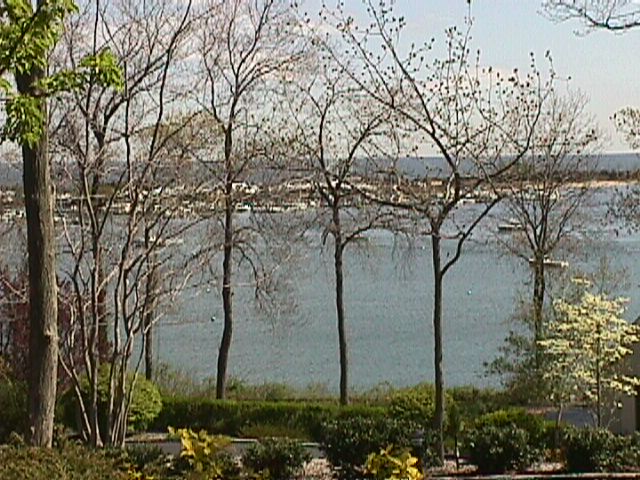
|
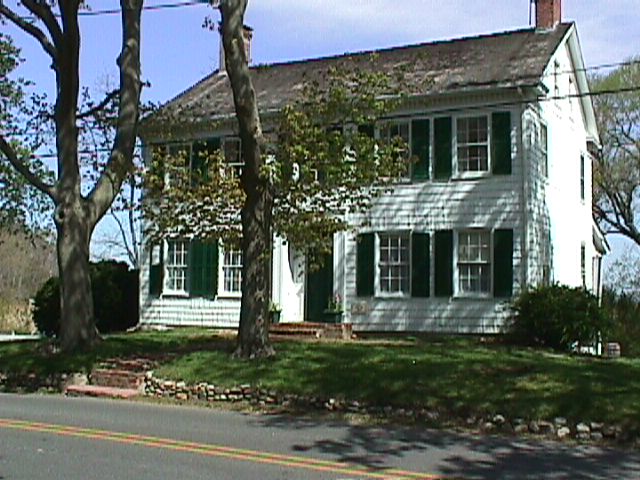
|
|
Mount Sinai Harbor
|
The Norton House
Circa 1819
|
Mount Sinai is a quiet residential community nestled on the north shore of Long Island, New York. It is bounded by the Village of Port Jefferson to the west, the Long Island Sound to the north. Pipe Stave Hollow Road to the east, and the Mt. Sinai School District boundary to the south (Crystal Brook Hollow Road, Hickory Street, Canal Road and southeast to CR83). These boundaries roughly parallel postal zip 11766 and U.S. Census Tracts 1582.05 and 1583.06. The hamlet is a CDP (census design- place) that has enabled Suffolk County Planning Commission to publish assorted data for the hamlet of Mt. Sinai. Boundaries of census tracts have changed over the years. In 1960, the community had 1,239 persons increasing to 2,157 in 1970, 6,591 in 1980 and 8,023 in 1990. The median age is 32.7 and household and family incomes are 20 percent higher than the Town of Brookhaven. It has almost twice as many homes valued over $250,000 and few valued under $100,000.
HISTORY
Geologic origin - The glaciers from the north deposited sediments that now make up the foundation of Long Island. As the global climate warmed, melting ice and flowing waters eroded the dropped glacial sediments into the shape of a land called "Pamanouk" or the island we call Long Island. The island's northern bluffs were interrupted by several rivers and a number of harbors. One of these is now Mount Sinai Harbor.
After the glaciers receded, a barren land was available for habitation. Plants, animals and fungi invaded the landscape. A successional parade of different ecological communities developed through time on Long Island. New flora and fauna flourished. Human explorers noted these good places on the island. Soon other humans started to establish permanent communities. This pattern of settling at a good place continues to this day in the hamlet of Mt. Sinai.
Native Americans - Nonowatuck, stream that dries up, is the first name given to the area we now know as Mt. Sinai. This native American name was used by the members of the Seatocots family of native Americans who lived here. Numerous archeological sites document that the harbor of Mt. Sinai was home for human residents for thousands of years.
An investigation of an archeological site at Hopkin's Landing, on Pipe Stave Hollow Road, yielded features that provided clues to these first residents. Shallow oval basins were lined with fire-cracked rock. The basins contained shell, bone fragments and debitage from stone tool-making. Evidently these first residents enjoyed deer and bay scallops. Charcoal fragments from this site dated back approximately 4,000 years. Thus, native Americans, the first residents of MT Sinai, lived in a self-sustaining community from about 2000 B.C. until the late 1600's. They were nourished by the bounty of the land and the harbor.
Colonial Settling - Colonial settlers living in what is now Setauket began negotiations with the local native Americans to buy the lands east of Setauket. At that time the area was called Old Mans (Ould Mans). Finally in 1664 the settlers were successful in obtaining a deed to this land from the Indians. This deed which is in the records of Brookhaven Township, reads as follows:
|
"Massatewse and the Sunke Squaw. native proprietors and owners
of all the lands belonging to the tracte of land commonly cawled
the Ould Mans. doe freely and absoleutilly sell and will defend
the title to the inhabitants of Setawke and their successors for-
ever for and in consideration of a certaine valey of goods here
under written to be delivered within one month after the date
hereof as witness our hands this 10 of June, 1664.
Massatewse X Mark
The Sunke Sqaw X Mark
Signed in the presence of us:
John Cooper
Richard Howell
foure cotes, foure payre of stockeing. too chestes of powder, tenn
bares of led. sixe howse. tenn hatchetts and tenn knives, mens
size cotes, foure sherts, 3 pekle kettles.
This is a trew coppey of the original
of attest
Rog Barton recorder
The above written record the contents thereof, with all the severall
kinds of pay reed excepting kettle howse and hatches by Mayho
and Massatuse.
|
After the initial purchase of land, various parcels of the territory were divided and given to individuals. Other lands were held in common for later subdivision. Once lots were distributed, trading began, allowing individuals to accumulate larger pieces of property in the area. Colonial families settled on these lands and established farms and a few businesses. The purchase and division of the land into private and public land in 1664 laid the foundation for the land ownership and development now seen in the Hamlet of Mt. Sinai in 1995. The vast majority of land is in private ownership, but the Town of Brookhaven owns and manages the common lands of most of Mt. Sinai Harbor and Cedar Beach
Hamlet's First Name and Boundary - The origin of the name Old Mans is not known. Several legends exist as to the source of the name. The most prominent concerns John Scott, a notorious wheeler-dealer of the 1600's and Major John Gotherson, an elderly Englishman looking to buy land in the new world. John Scott assured Major Gotherson he could obtain property for him but never closed a deal even though Gotherson had given him money to do so. "Old" Major Gotherson living in England, thought he owned the land. He sent representatives to claim the land he thought he owned. The native Americans refused to turn over the land since they hadn't closed a deal with Scott. Local people reportedly started to refer to the land as "the Old Mans" lands the news of the swindle was discussed.
Although the exact boundary of Old Mans is not known, it is said to have reached from what is now Port Jefferson to Rocky Point. By 1770 the name came to mean the area bounded by the Sound to the north, Pipe Stave Hollow to the east, approximately "Rte 25A" to the south and Crystal Brook Hollow to the west.
During the American Revolution, the area and Old's Harbor were under British control. However, because of its remote location the British did not have troops stationed here. Many citizens moved their families to Connecticut during British occupation. During the course of the war, American agents visited local patriots and received information, clothing, supplies and money to support the cause.
Pipe Stave Hollow is located along the eastern border of the hamlet. The brook that "dries up" empties into the harbor at Hopkin's landing. The name is said to be derived from the many wooden staves which were cut in the area to be used to make large "staves" that were used to construct wooden pipes. Pipe Stave Hollow Road winds its way along the harbor and to the beach. During the revolutionary war, Col. Benjamin Tallmadge used this beach as a landing and hiding place for his eight whaling boats. He set off along Pipe Stave Hollow Road and traveled south to attack the British at Fort St. George in Mastic. The route he and his men took is now marked as a historic trail.
Hamlet's Name Change and Development -
In 1840 the people of Old Mans applied for a post office. Evidently Old Mans was not considered a proper name for the area. The name was changed to Mt. Vernon. This name was used for only a year since it was discovered there already was a Mt Vernon in New York State. Old Mans was used once again but for some unknown reason another name change occurred. The name Mount Sinai was chosen by the first postmaster, Charles Phillips. Legend says that he took his Bible and a knitting needle, closing his eyes, he opened the Bible and pointed the needle. The name closest to the needle would become the name of the area served by the first post office. Mt Sinai replaced Old Mans and is the name residents have used since 1841/1842.
Building of houses occurred in spurts. Initially most building occurred within a mile of the harbor. Few houses were built south of North Country Road until the late 19th century. Much of the land south of North Country Road was owned and cultivated by farmers.
|
There is no known 17th structure still standing. The 18th century is represented by six buildings dating from 1705 to 1790. Certain of these homes have structural elements which date from the early period. The 19th century has the largest number of surviving historical structures. These can be divided into two periods,1800-184O's and l880-1890's Again some of these buildings incorporated structural elements of earlier periods.
|
 |
|
The Ketchum House
Circa 1832
|
In the first half of the 2Oth century the pace of building slowed. Although large tracts of farmland persisted, there were small pockets of development around the hamlet. Examples of these are the "colony" of homes built off of Pipe Stave Hollow Road, both north and south of Rte. 25A and the scattered development on Mt. Sinai and Chestnut Avenues. During this time a community was mapped but never developed just south of Rte. 25A and east of Crystal Brook Hollow Road.
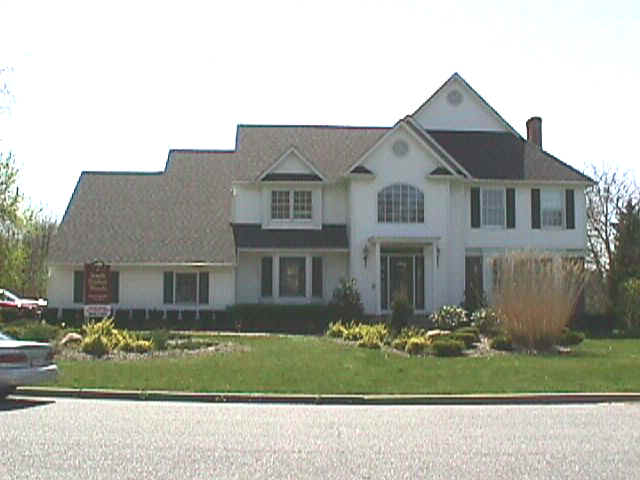
|
It was not until the 1960's that housing developments began to occur as suburbanization spread eastward. Lands once farmed, now were used to "sprout" homes for new residents of Mt. Sinai. New residents were attracted to the area for the same reasons that the first native Americans settled in Nonowatuck.
The hamlet was peaceful, quiet and rural. The harbor and Sound were nearby and provided a place to enjoy diverse forms of marine recreation.
|
New Home Construction
in Mt. Sinai
|
|
Farming -
Farming was the main occupation for residents from the 1660's to the 1960's. The lands bought from native Americans and divided up by colonialists shifted from a hunting, fishing, farming habitat that sustained the native population to a transplanted European population that farmed to sustain themselves and ship farm and forest products to cities to the north and west. Vegetable and dairy faring continued to be important into the l96Os. In 1995 approximately 400 acres are still farmed, producing sod, pumpkins, vegetables and fruits.
Work, Trades and Commerce -
Occupations relating to the harbor and shipping also kept varying numbers of residents busy. Many young men preferred to pursue careers at sea than stay on the farm. Some families of Mt. Sinai had sons engaged in world wide shipping while others were engaged in shipping throughout Long Island Sound and along the east coast.
As shipping trade increased, new ships had to be built The local forests provided the wood to ship builders in Port Jefferson. There was a shipbuilding yard in Old Mans also. However, the unstable mouth and the shallow depth of the harbor limited the size of the ships that could be built at Old Mans. Eventually the yard was moved to the naturally deeper harbor of Port Jefferson. Riggers, sail-makers, ship carpenters and others lived in Mt Sinai and commuted to Port Jefferson. Blacksmiths, shoemakers, schoolteachers, salesmen, carpenters and storekeepers worked in the hamlet of Mt. Sinai. Grist mills were located somewhere along Pipe Stave Hollow and Crystal Brook Hollow Roads. Records indicate that a number of windmills were located on the hills overlooking the harbor. These no doubt ground grain. General stores were a part of the community since the early 1800’s. John Hutchinson had a store near the harbor that conducted business until the early 1900's. Vincent R Davis had a store near the school on North Country Road from 1890's to 1917. Floyd Davis took over V.R. Davis' store and eventually moved it to the northeast corner of North Country Road and the New Road (Mt. Sinai Coram Road). This building has housed a variety of businesses through time and a business continues in it to this day.
|
The post office, established in 1840, was kept in Charles Phillip's house on North Country Road. In 1908, V.R. Davis replaced Eliza C. Randall as postmaster and moved the post office to his store. When Floyd Davis became postmaster, he moved the post office to his store on the corner of North Country Road and Mt. Sinai-Coram Road. The post office and a general store served the community until the late 1960's. At that time, a new post office was built on Route 25A. Thus the union of general store and post office that lasted for about 6O years came to an end.
|
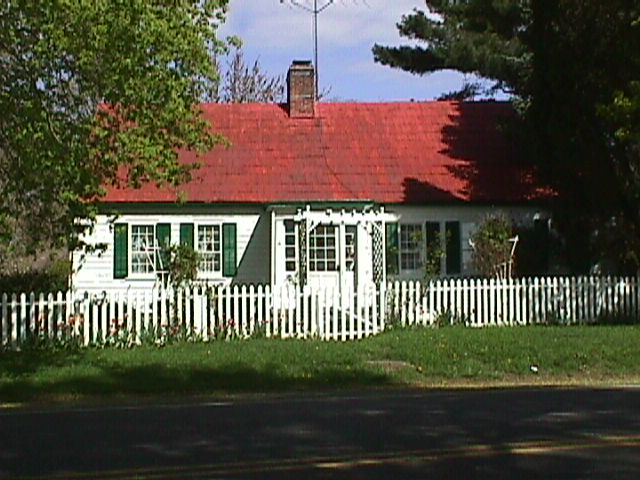
|
|
As the population in the hamlet grew, new businesses were established to serve the community and surrounding communities.. Many of these located on Route 25A. The once simple demands of the colonial community evolved into more complex demands of a modern community. Like many other suburban communities on Long Island, a commercial center did not develop in Mt. Sinai. At one point a school, the post office and a few stores served as the commercial center of Mt. Sinai along North Country Road. No such nuclear development has occurred in the hamlet. Citizens must drive to different parts of the community and other communities to work and to buy the things they need.
Education -
Education has been important to the community since the early 1820's and probably earlier. The location of the original school building is Unknown. However, tradition places it on North Country Road east of Mt Sinai Coram Road. The second one-room school was built in 1869 on a half acre of land on the southeast corner of North Country and Mt Sinai Coram Road In 1908 a second classroom was added. This building served the community until 1960. At that time the community decided to send their children to be educated in Port Jefferson. In 1960, the school was moved and a firehouse was built on the property.
Religion -
|
Religion has also been an important part of community life. Before 1740 people had to travel to Setauket for services. In the 174O's a Presbyterian Church was built. There is no other information known about this church. In 1789, nine worshipers established the Congregational Church using the old church building as a place to worship. In 1807 a new building was erected and continues to be used as the Mt. Sinai Congregational Church. In the early 1800’s, a congregation built a Methodist-Episcopal Church on Shore Road.
|
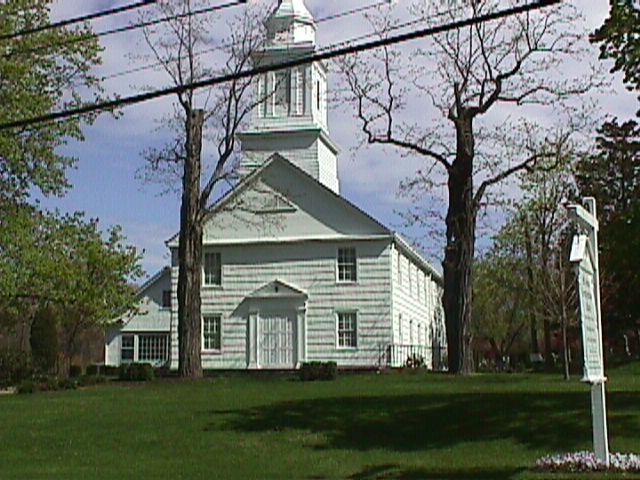
|
|
The church continued until 1900 when the Mt. Sinai church united with the Methodist Church in Port Jefferson The church building was sold and used as a private home.
|
Civic Action -
The Mt. Sinai Civic Association was founded in 1917. Since that time the Association has been involved in community affairs. The activities of the Association have waxed and waned with the times. The sand dredging, the maintenance of the harbor's mouth and the care of roads were a concern in the early 1900's. After WW II another effort to mine sand and "develop" the harbor occurred. The Association, along with other civic associations and the Mt Sinai Harbor Association, prevented the early plans for development but could not convince the Town of Brookhaven to stop the dredging of the northern part of the harbor. Through the efforts of many different community groups (Civic and Conservation) the dredging was stopped.
Community Groups -
There have always been many other community groups active within the hamlet. They are affiliated with the fire department, the school, scouts and churches to name a few.
Mt. Sinai's Harbor -
The quiet harbor with a ready access to Long Island Sound provides a pleasant place to vacation. Even in the 1800's people from New York City and Connecticut came to Mt. Sinai to escape the congestion of city neighborhoods. In the early 1800’s men came to hunt. The LIRR opened up lines to Yaphank, Port Jefferson and Wading River. Ships also provided transport for people. The post roads, the railroad and the sloops of the Sound provided the access to peaceful places like Mt Sinai and Miller Place. Vacationers stayed at private homes or small hotels. Some families who visited the area found the area to their liking and bought land or houses here. Some stayed just for the summer, just as families now summer on the east end of Long Island. Activities included baseball, croquet, card games, dancing, theatrical productions, social events, swimming, boating and fishing. All of these activities were primarily enjoyed by the tourists. It was rare for the locals to participate in the activities since they were involved in working on the farms or working to take care of the vacationers.
The harbor was the prime attraction for the lazy days of the summer. Vacationers enjoyed going to Satterly's Landing boathouse. Boats were rented for an easy row about the harbor or for fishing in the Sound. The harbor was also a point to set sail for a few days sail across the Sound. People also enjoyed swimming in the waters of the harbor or Sound.
Mt Sinai has always served as a resource to the population living around it or visiting it. It provides a variety of shell and finfish. Migrating waterfowl have been hunted during their short stays in the harbor. Early settlers harvested salt hay from the salt marshes and fed it to their livestock. The original mouth of the harbor was on the east side. Winds and tides continually narrowed its opening. Local residents toiled at widening the mouth. In the mid 1800’s a new mouth was dredged on the west side of the harbor. Tides continue to dump sand, narrowing the mouth of the harbor. It still must be dredged to keep it open to allow for the boats moored in the harbor to reach the Sound. To this day, people clam in the harbor, collect salt hay to mulch their gardens, fish for flounder and snapper, and to a limited degree hunt ducks during the winter. However, the clams aren't as big and the fish and fowl are scarcer.
The harbor and surrounding lands have also provided another resource. sand. At varying times sand milling was done to satisfy the demands for sand for the rapidly growing urban areas. This use of the harbor became a center of controversy. It united locals with the summer residents, and residents from around the Town to fend off plans that would damage or destroy the harbor. Three major civic battles were waged in the 20th century when various plans to dredge the harbor were proposed and pursued by the Town of Brookhaven. Since the harbor was common land owned by Brookhaven, the elected trustees could allow dredging and sand milling to occur. Two dredging projects were approved and the present channels and deep basin south of Cedar Beach are the result of that action. A united civic action finally got the dredges out of the harbor in the late 1960s.
The northern part of Mt Sinai Harbor and Cedar Beach is an active recreation area, with a fraction of the original sand dune community preserved in a Marine Sanctuary. Commonly owned lands set aside in 1664 are being used for public recreation or have been rented for private use by a fishing station/boatyard, yacht club and a marina/boatyard. Town and private enterprises provide space and services for boating and fishing. A number of commercial fishermen work out of the harbor and fish in Long Island Sound. Cedar Beach also provides facilities for swimming, teen summer recreation programs, and a nature study center.
The southern part of it is a passive, peaceful place. This area retains some of the same characteristics of earlier times. The tides control the use by citizens. Low tides allow clammers to clam; high tides attract a few fishermen and a few boaters. Citizens come and sit to enjoy the natural habitat regardless of the tide.
The difference in the two parts of the harbor can also speak for the hamlet in general. Part of the hamlet was laid out and settled in the days of horses and wagons. The hilly terrain, the curving roads, the backdrop of mature forests and the scattering of historic houses are reminders of by-gone days and help retain a sense of history. In the newly settled areas of the community, developed during the auto age, roads are matched to the use of automobiles, houses are built in modern developments, and the landscape is maturing with the help of landscapers. together, we all make up a hamlet that is a blend of old and new. All seem to agree with the first native American residents that the hamlet provides us with a peaceful place to live.
NATURAL RESOURCES
The natural resources of any community located on Long Island, NY are the result of the evolution of the living organisms with the landscape of the island over geological time in combination with the influence of humans - first the Native Americans and then the colonizing Europeans. Human beings not only changed natural communities through physical alteration of their habitats (burning, logging, farming, dredging, filling) but also through alteration of their complex food webs by eliminating native species (over harvesting, removing habitat) and replacing them with others (introduced from other parts of the world).
The hamlet of Mt. Sinai is typical of many places on the north shore of Long Island, N.Y. Natural habitats in the area range from beaches and salt marshes adjacent to Long Island Sound in the north to old field successional grasslands and secondary-growth woodland in the central and southern portion. All of these habitats have been and continue to be altered by natural forces and human activity.
|
Mt. Sinai Harbor -
The most prominent natural feature of Mt. Sinai hamlet is an embayment on the Long Island Sound. Mt. Sinai Harbor is one of very few large, relatively undeveloped embayments remaining on the north shore of Long Island. It is typical of embayments along the southern edge of Long Island Sound in that it is the flooded remnant of a valley originally cut by a stream but later modified by several stages of glacial erosion and sediment deposition during the Ice Age.
|
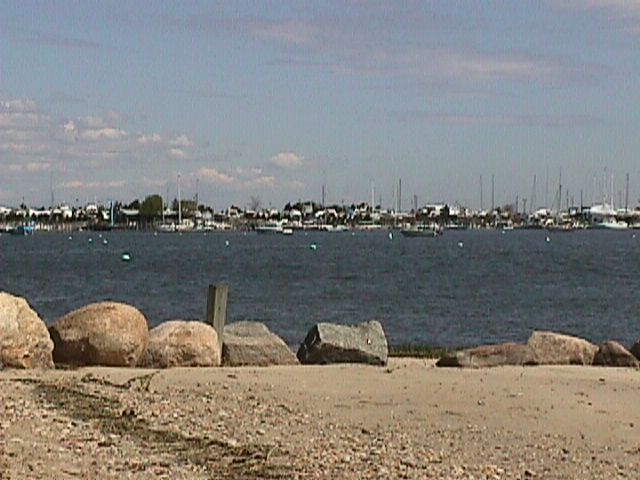
|
Such valleys were cut by glaciers into an elevated plateau consisting of Cretaceous rocks overlaid by the gravels of the Manhasset formation. This action resulted in the formation of peninsulas, or "necks" that are bordered by bluffs on the Sound. The uplands take the form of ridges perpendicular to the Sound. The valleys or hollows through which the streams ran remain, but the creeks have dried up and roadways were built along these courses.
The Harbor is 455 acres in area and consists almost exclusively of salt marsh, mudflats, and open waters, except for the area along the southern part of Cedar Beach which is heavily developed as a marina and boat mooring area. Most of the marshland in the harbor is owned by the Town of Brookhaven for conservation purposes. A small property in the southwest portion of the harbor is owned by the New York State Department of Environmental Conservation ((NYSDEC) for preservation purposes. The Town also maintains a small park adjacent to the marsh on the southwest side. The Harbor is accessible from the Sound via an inlet stabilized by a rock jetty. The inlet is dredged to maintain its depth. There are two sandy barrier bars of unequal length on either side of the inlet which protect the embayment from the strong physical activity of the Sound. The much longer, east-side spit is maintained as a Town park, Cedar Beach, at the eastern end. Park facilities include a large parking lot, restrooms, and a nature center. The western end contains the Mt. Sinai Yacht Club. The back side of the spit is developed as a marina able to dock a large number of boats. Between the marinas and the mooring areas, this northern basin can hold more than 300 boats on a typical summer day. The short western spit is undeveloped and connects to the Port Jefferoon Village Beach to the west. At various times it has provided nesting areas for a number of shorebirds.
Most of the land around the Harbor is zoned for residential use and has been developed accordingly. Several upland parcels are zoned for one unit per acre residential use but have not been developed.
Special thanks to the Mt. Sinai Hamlet Study committee for all of the above information.